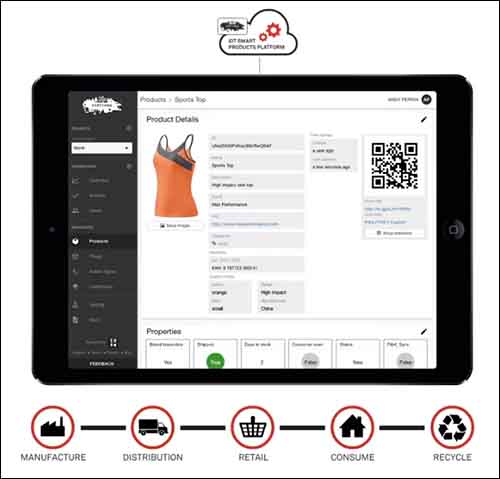Jul 21, 2017Internet of Things smart products platform company EVRYTHNG has teamed up with Avery Dennison Retail Branding and Information Solutions (RBIS) to provide a solution that makes it possible for consumers to engage with digital applications and access information about a product using a brand's or retailer's EPC UHF RFID tag or other GS1 identifier attached to that item. The system is called Active Digital Identities (ADI).
The solution enables brands and retailers to create an Active Digital Identity for each tagged product. That ADI resides on a cloud-based platform, to be shared or accessed according to a user's particular needs—for inventory tracking via RFID, as well as for providing content access to customers via a QR code.
The ADI is enabled by Avery Dennison RBIS's Janela solution, powered by EVRYTHNG's Smart Products Platform. Janela was launched last year to enable this kind of activity, explains Bill Toney, Avery Dennison's RFID market-development VP (see Avery Dennison Aims to Deliver Product Info Via RFID, Bar Codes).
The solution makes information and applications available to consumers who scan a QR code or datamatrix on an EPC UHF RFID tag compliant with GS1's RFID standard, and stores data about each transaction in the cloud. EVRYTHNG refers to the new tags as dual-trigger price tickets. Companies could make data about a product accessible on a single price tag, either by reading the tags with RFID readers (this is typically done by the store or brand employees), or by performing QR code scans in which consumers use a smartphone to access data. In this way, a single label can be used to manage inventory via the RFID tag, and consumer-facing content with the 2D bar code. The solution is expected to enable in-store applications such as self-checkout, as well as out-of-store uses for reordering products and access to product information.
The ADI provides a unique digital identity on the Web to manage data from and about a product, that consumers and businesses alike can use to access information, according to Niall Murphy, EVRYTHNG's co-founder and CEO. The ADI technology standardizes the GS1 ID number encoded on a tag and the matching serial number, so that each unique ID can automatically produce specific data from a cloud platform. The solution works with any GS1 ID, the firm repots. While EPC UHF RFID tags could be used, HF RFID or Near Field Communication (NFC) tags and bar codes could as well, as long as they use GS1 standards identifiers.
The data stored on the cloud and linked to that unique ID could then be accessed in preauthorized categories by brands, retailers, logistics providers and customers, and could include such descriptors as size, color or ingredients. Users could also potentially access sensor-based data or other status information, such as the temperature at which it was stored, its availability or its price, along with such actions as shipping, receiving or purchasing.
The Janela solution with EVRYTHNG's technology can also store and provide analytics for businesses, such as custom dashboards and data visualizations intended to offer companies a better understanding of the movement and status of their products. A company could attach a price tag to a product as it is manufactured, with a built-in EPC UHF RFID tag encoded with the same unique ID number as the one printed on the tag's front in the form of a 2D bar code. That product's identity and life history would then be stored on the cloud platform.
The RFID tag would be read as the product moved from the manufacturer through the supply chain to the store, and as it was then received and put on display at the store. Typically, RFID tags have completed their useful life at this point, unless they are used for managing returns.
With the 2D bar code printed on the label as well, linked to the EPC RFID number, companies can allow consumers to access some of that data. For those that want to enable customers to purchase a product using their cell phones, the firm reports, the ADI solution would make that possible.
Consumers would simply scan the 2D bar code on the product to access information about it. If they opted to make a purchase, the solution would offer that option, and they could simply provide their payment information and complete the purchase, with no app necessary. The solution could then forward that data to the inventory-management software in order to update the inventory data at that store, and to prompt a replenishment order if necessary. Other use cases include simply providing additional product information to the consumer, as well as offering access to content regarding other products that would go well with it.
After taking the product home, the shopper could continue to interact with that item's tag to access information about it, or to learn where parts, replacements or accessories could be purchased. Businesses could then use the ADI in the cloud to create business analytics around the customer's behavior, such as how often that person accessed content via the tag, and what content interested him or her.
While some businesses are looking into applying the new GS1 EPC standards for encoding on their product items—which link directly with Active Digital Identities—as they are manufactured and tagged, the ADIs can also be applied with the GS1 identifiers in existing QR codes, as well as RFID or other GS1 identifier labels. "That allows a company already using GS1 identifiers to easily digitize their products," Murphy states.
Billions of tags worldwide already have a GS1 identifier in the form of a bar code or EPC UHF RFID tag, Murphy says, though the solutions are fragmented. "What EVRYTHNG does is provide a digital ID in the cloud," he explains, "where any data about that item can be stored and managed throughout the product lifecycle."



